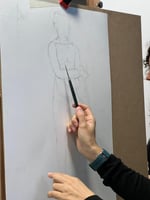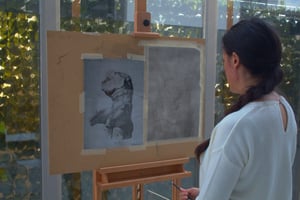Art is a universal language that can be appreciated by people of all cultures. It is a way to...
Exploring The Artistic Strengths Of Dyslexia

Unveil the unique artistic capabilities that dyslexia brings to light, transcending traditional learning difficulties to reveal a world of creative potential.
Understanding Dyslexia Beyond Its Challenges
Dyslexia is often misunderstood and viewed solely through the lens of its challenges, especially in the realms of reading and writing. However, 'The Dyslexic Advantage' sheds light on a different perspective, emphasizing the cognitive strengths that come hand in hand with this condition. The book outlines four key advantages: material reasoning, which involves the ability to grasp and retain the structure of objects; interconnected reasoning, allowing for the recognition of connections between seemingly disparate concepts; narrative reasoning, facilitating the construction and recollection of personal stories; and dynamic reasoning, enabling accurate predictions of change and motion. These cognitive strengths not only empower individuals with dyslexia but also pave the way for exceptional artistic abilities. From a heightened perception of visual structures to innovative problem-solving in design and a distinctive storytelling approach in the visual arts, dyslexic individuals bring a unique and invaluable perspective to the creative world.
The Cognitive Advantages of Dyslexia in Art
The cognitive advantages of dyslexia have a profound impact on artistic abilities. Dyslexic individuals often excel in fields that require spatial and visual reasoning. Material reasoning enhances an artist’s ability to perceive depth and form, making sculptures and paintings come alive. Interconnected reasoning allows artists to create complex, layered works that invite viewers to explore deeper meanings. Narrative reasoning enables the creation of compelling visual stories, engaging audiences emotionally. Lastly, dynamic reasoning gives rise to artworks that convey movement and transformation, captivating the viewer’s imagination.
Understanding these cognitive advantages is crucial not only for appreciating the unique talents of dyslexic individuals but also for fostering environments that encourage their creative expression.
Showcasing Success: Artists with Dyslexia
In the vast and diverse landscape of the art world, the presence of successful artists with dyslexia shines brightly, illuminating the path for others to embrace their unique cognitive strengths. These talented individuals bring a fresh and innovative perspective to visual space, effortlessly navigating through patterns and structures to create artworks that captivate and inspire. Their ability to weave intricate narratives through images is a testament to their exceptional storytelling skills, drawing viewers into a world that is rich, multidimensional, and profoundly impactful. By shining a spotlight on the achievements of artists with dyslexia, we not only break down barriers and challenge misconceptions but also highlight the immense value and creativity that dyslexic thinking brings to the vibrant tapestry of visual culture.
Art as a Therapeutic Medium for Dyslexia
Art serves as a powerful and transformative medium for individuals with dyslexia, offering a gateway to express their inner thoughts and emotions in a way that transcends traditional verbal communication. Through the visual arts, individuals with dyslexia can tap into their unique cognitive strengths, allowing them to convey complex ideas and feelings with depth and clarity. For many, the act of creating art goes beyond mere self-expression; it becomes a therapeutic journey that enables them to navigate their inner world and communicate their innermost thoughts and emotions in a way that feels natural and intuitive.
Engaging in the artistic process can be profoundly empowering for individuals with dyslexia, as it provides a sense of accomplishment and a means to connect with others on a deeper, more profound level. Through their artwork, they are able to forge connections, share their stories, and evoke emotions that resonate with others. Art becomes a bridge that transcends barriers, allowing individuals with dyslexia to communicate in a language that is universal and deeply impactful.
In this way, art becomes not just a form of creative expression, but a therapeutic tool that nurtures the mind, body, and soul. It offers a safe space for individuals with dyslexia to explore their creativity, confront their challenges, and express themselves authentically. Through the act of creating art, they find solace, healing, and a sense of belonging in a world that often misunderstands their unique way of processing information. Art becomes a sanctuary where they can truly be themselves, free from judgment and limitations, and where their voices can be heard and celebrated.
Designing Art Programs for Dyslexic Learners
Art programs play a crucial role in supporting dyslexic students by providing a platform for them to harness their unique cognitive strengths and unleash their creative potential. Educators can create tailored strategies that specifically target the visual and spatial abilities of dyslexic learners, empowering them to express themselves through art in ways that traditional learning methods may not allow. By offering hands-on, experiential learning experiences and encouraging exploration in various art mediums, educators can help dyslexic students discover new ways of communicating and connecting with the world around them.
In a classroom environment that values innovative thinking and problem-solving, dyslexic students can thrive and shine. Educators who understand and embrace the diverse ways in which dyslexic students process information can cultivate an inclusive atmosphere where artistic expression is not only encouraged but celebrated. By tapping into the strengths of dyslexic learners, educators can nurture their artistic abilities and foster a sense of confidence and self-esteem that extends beyond the art studio.
Practical strategies such as incorporating visual aids, utilizing technology that supports visual learning, and providing personalized feedback that highlights the student's strengths can make a significant impact on the artistic development of dyslexic learners. By tailoring instruction to meet the unique needs of each student, educators can create a supportive and empowering environment where dyslexic students can thrive and grow as artists. Through these strategies, dyslexic learners can not only enhance their artistic skills but also gain a sense of pride and accomplishment in their abilities, paving the way for a brighter and more confident future.



